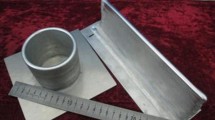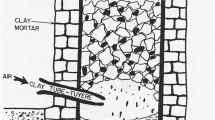Abstract
Tatara, a traditional steel-making system developed in Japan, and the Japanese sword are briefly introduced from a technological point of view, followed by some comments on scientific aspects. Attention is paid to the comparison with methods developed in foreign countries. The quenching process being operated in the final stage of sword making is focused on, and results of a computer simulation by a code COSMAP based on metallo-thermo-mechanics are presented to know how the temperature, metallic structure and stress/distortion vary in the process.
Similar content being viewed by others
References
Kapp L., Kapp H., Yoshihara Y.: The Craft of the Japanese sword. Kodansha International, Tokyo (1987)
Kanzan K.: The Japanese Sword—A Comprehensive Guide. Kodansha International, Tokyo (1983)
Robinson B.W.: The Arts of the Japanese Sword. Farber and Faber, London (1960)
Tawara K.: Scientific Research on Japanese Swords (in Japanese). Hitachi-hyoronsha, Tokyo (1953)
Bain, B.C.: Nippon-to, an introduction of old swords of Japan. J. Iron and Steel Institute of Japan. 265–282 (1962)
Suzuki T.: Traditional Technology of Making Japanese Swords (in Japanese). Rikougaku-sha, Tokyo (1994)
Ishikawa K.: Nippon-Toh (Japanese Sword)—High-Technology Threading Through History, Lecture Note. Rochester Institute of Technology, Rochester (1993)
Fujiwara, H., Hanabusa, T.: Scientific research of Japanese sword—its curvature (sori) and residual stresses (in Japanese), Research Report, Faculty of Engineering, Tokushima University, 1 (1993)
Fujiwara H., Hanabusa T., Tanaka K.: Scientific research of Japanese sword—its curvature (sori) and residual stresses. Proc. 3rd Int. Conf. Residual Stresses 2, 1537–1542 (1991)
Williams A.R.: Seven swords of the renaissance from an analytical point of view. Glaudius 14, 97–127 (1978)
Inoue T.: Tatara and the Japanese sword—-Advanced science and technology in the Japanese sword (in Japanese). Journal of the Japan Society of Mechanical Engineers. 97-903, 132–135 (1998)
Park J.S.: Traditional Japanese sword making from a tatara ingot from microstructural examination. ISIJ Int. 44-6, 1040–1048 (2004)
Sasaki N., Momono T.: Change in carbon content of materials of the Japanese sword under traditional forging process. JISI Int. 93-12, 792–798 (2007)
Matsumoto, K., Miyamoto, Y., Shimura, F.: Scientific connoisseur of a Japanese sword by minute impurity analysis. In: Proceedings of Annual Meeting of the Society for Scientific Studies of Cultural Properties (2006)
Yamada H.: An engineering study on Nippon-Tou (in Japanese). J. Adv. Mach. 23-1, 3–12 (2004)
Yamada H., Sugita T., Ishikawa K.: A study of sharpness edge tool—2nd report; relation between cutting force and cutting condition. J. Adv. Mach. 19-1, 49–53 (2000)
Yamasue E.: Effect of size for tatara steelmaking furnace (in Japanese). Tetsu-to-Hagane 19-1, 1–7 (2005)
Daimaruya, M., Kobayashi, H., Fujiki, H.: Impact Response of a model of a Japanese sword with Sori (in Japanese). In: Proceedings of 2006 Annual Meeting of JSME/MMD, pp.149–150 (2006)
Committee on Restoration Project of Tatara Steel-making System, Restoration of Tatara steelmaking process and the Blister steel (in Japanese), ISIJ-special report No. 9 (1970)
Matsushita Y.: Restoration of the “Tatara” ironmaking process, an ancient ironmaking process of Japan (in Japanese). Proc. Int. Conf. Sci. Technol. Iron Steel Trans. ISIJ 11, 212–218 (1971)
Kozuka J.: “Tatara” process—a pig iron- and steel making process, transmitted from ancient times in Japan (in Japanese). Trans. ISIJ 8, 36–47 (1968)
Kubota, K.: Japan’s original steel making and its development under the influence of foreign technique (in Japanese). Coll. Int. Inst. CNRS, No.538 577–591 (1970)
Horikawa K.: The ancient nails of “Horyuji” temple and the restoration of the “Tatara” ironmaking process (in Japanese). Bull. Metals Museum 12, 29–37 (1982)
Uehara T., Inoue T.: Quenching process simulation of Japanese sword covered with clay (in Japanese). J. Soc. Mater. Sci. Japan 44, 309–315 (1995)
Inoue T.: Japanese sword in science and technology–computer simulation of quenching process (in Japanese). Boundary 11, 36–41 (1995)
Inoue T.: The Japanese sword—material, forging and simulation of quenching (in Japanese). Materia 135, 174–178 (1996)
Inoue T.: The Japanese sword—the material, manufacturing and computer simulation of quenching process. Mater. Sci. Res. Int. 3-4, 193–203 (1997)
Inoue, T.: The Japanese sword—the material, manufacturing and computer simulation of quenching process, 2002. J. South African Arms and Armour Soc. 108–142 (2002)
Inoue, T.: Japanese sword in comparison with others. In: Proceedings of 8th International Conference on Mechanical Behaviour of Materials, pp. 458–468. Victoria, Canada, 16–21 May 1999
Inoue, T.: Science of Tatara and Japanese sword–traditional technology viewed from modern science. In: Proceedings of 1st International Conference on Business and Technology Transfer, pp. 131–138 (2002)
Inoue T.: Scientific rationality in the Japanese sword (in Japanese). J. Japan Soc. Mech. Eng. 107-1027, 132–135 (2004)
Inoue T.: The science of Tatara and Japanese sword Part I (in Japanese). Kogyo-kanetsu 42-2, 5–11 (2005)
Inoue T.: The science of Tatara and Japanese sword Part II (in Japanese). Kogyo-kanetsu 42-3, 3–9 (2005)
Inoue, T.: Science of Tatara and Japanese sword (in Japanese). In: Proceedings of 2006 Summer Conference, pp. 1–7. Soiety of Automotive Engineers of Japan (2006)
Inoue T.: The Japanese sword—the art, comparison with foreign swords and metallo-thermomechanical simulation of quenching process (in Japanese). Materia 47-7, 359–363 (2008)
Inoue T., Nagaki S., Kishino T., Monkawa M.: Description of transformation kinetics, heat conduction and elastic-plastic stresses in the course of quenching and tempering of some steels. Ing.-Archiv 50, 315–327 (1981)
Inoue T.: Metallo-thermo-mechanical coupling—application to the analysis of quenching, welding and continuous casting processes. Berg-und Hutten-mannische Monatshefte 132, 63–71 (1987)
Inoue, T., Ju, D.Y., Arimoto, K.: Metallo-thermo-mechanical simulation of quenching process—theory, and implementation of computer code “HEARTS”. In: Proceedings of 1st International Conference Quenching and Control of Distortion, pp. 205–212 (1992)
Inoue T., Arimoto K.: Development and implementation of CAE system “HEARTS” for heat treatment simulation based on metallo-thermo-mechanics. J. Mater. Eng. Perform. ASM 6-1, 51–60 (1997)
Inoue, T.: Inelastic constitutive relationships and applications to some thermomechanical processes involving phase transformation, thermal stresses. In: Hetnarski, R.B. (ed.) vol. 3, pp. 1–20. North-Holland (1988)
Inoue, T., Wang, Z.G.: Metallo-thermo-mechanical simulation of some processes incorporating phase transformation, computational plasticity—current Japanese materials research. vol. 7, pp. 1–25. Elsevier Applied Science (1990)
Inoue, T.: Macro-, meso- and micro-scopic metallo-thermo-mechanics—application to phase transformation incorporating process simulation, Material Science Research International. 10-1, pp. 1–11 (2004-3)
Inoue, T.: Macro-, meso- and micro-scopic metallo-thermo-mechanics, J. de Physique V. 120, 3–20 (2004-12)
Inoue T.: Makro-Mezo-i Mikroskopowe Sposoby Oceny Przemian Fazowych w Metalach Uwzgled-najace Proces Symulacji Komputerowej. Inzynieria powierzchni, Nr 1, 23–35 (2005)
Inoue, T.: Metallo-thermo-mechanics—application to quenching, Handbook of Residual Stress and Distortion in Steel (Coedited by Totten, G., Morse H., Inoue, T.) ASM-International, pp. 296–311 (2002)
Inoue, T.: Thermal-metallurgical-mechanical inter-actions during welding, progress and mechanism of welding residual stress and distortion In: Feng, Z. (ed.) Woodhead Publishing Ltd. pp. 99–125 (2005-11)
Ju, D.Y., Ito, Y., Inoue, T.: Simulation and verification of residual stresses and distortion in carburized-quenching process of a gear shaft. In: Proceedings of 4th International Conference on Quenching and the Control of Distortion, pp. 291–296. Beijing 20–23 May 2003
Ju D.Y., Inoue T.: On the material process simulation code COSMAP—simulation examples and its experimental verification for heat treatment process. Key Eng. Mater. 345-346, 955–958 (2007)
Ju, D.Y., Ito, Y., Inoue, T.: Simulation and experimental verification of carburized and nitrided quenching process. In: Proceedings of 3rd International Conference on Thermal Process Modelling and Simulation, Budapest (2006-5)
Ju, D.Y., Inoue, T.: Simulation and its experimental verification by a material process CAE code COSMAP. In: International Journal of Microstructure and Materials Properties (in press)
Maeder, S.: Stähle, Steine und Schlangen—Ein Beitrag zur Kulturgeschichte von Schwertklingen des frühen Mittelalters. Dissertation zur Enlangung des Doktorgrades der philosophischen Fukurtaten der Himboldt Universitat zu Berlin, 2001 (PhD-thesis), p. 340. Berlin (2001)
Inoue, T., Okamura, K.: Material database for simulation of metallo-thermo-mechanical fields. In: Proceedings of 5th International Symposium on Quenching and Distortion Control, pp.753-760. ASM, St. Louis (2000)
Subcommittee on Material Database, Committee on Engineering Plasticity, Materials database for simulation of metallo-thermo-mechanical fields (in Japanese). J. Mater. Sci. Japan. 51–3, 350–355 (2002)
Inoue T.: Unified transformation-thermoplasticity and the application (in Japanese). J. Soc. Mater. Sci. Japan 56–4, 352–356 (2007)
Inoue T.: Phenomenological mechanism of transformation plasticity and the constitutive law coupled with thermo-mechanical plasticity. Adv. Mater. Res. 33–37, 1351–1358 (2008)
Inoue, T.: Mechanism of transformation plasticity and the unified constitutive equation for transformation-thermo-mechanical plasticity with some applications. In: Proceedings of 2nd International Conference on Distortion Engineering, pp. 441–450. Bremen (2008)
Tanaka, T., Inoue T.: Identification of trans-formation plasticity coefficient for some steels during pearlite transformation and the dependence on chemical composition (in Japanese). J. Soc. Mater. Sci. Japan. 56–10 (2008) pp. 1036–1042
Johnson W.A., Mehl R.F.: Reaction kinetics in processes of nucleation and growth. Trans. AIME 135, 416–458 (1939)
Magee, C.L.: The Nucleation of Martensite, Ch.3, ASM (1968)
Kikuchi Y.: The effect of thin coating material on rapid cooling of hot metal in boiling liquid. Netsu Shori 46–6, 359–366 (2006)
Author information
Authors and Affiliations
Corresponding author
Rights and permissions
About this article
Cite this article
Inoue, T. Tatara and the Japanese sword: the science and technology. Acta Mech 214, 17–30 (2010). https://doi.org/10.1007/s00707-010-0308-7
Received:
Revised:
Published:
Issue Date:
DOI: https://doi.org/10.1007/s00707-010-0308-7




